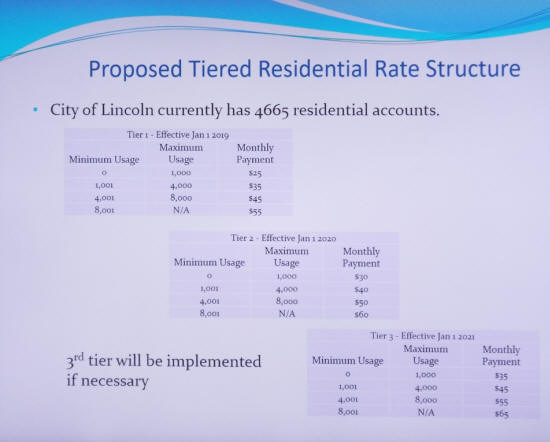|
Lincoln aldermen decide new
sewerage rate structure
 Send a link to a friend
Send a link to a friend
 [November 29, 2018] [November 29, 2018]
LINCOLN
At the Tuesday evening Lincoln City Council Committee of the Whole,
aldermen instructed city attorney John Hoblit to draft ordinance
documents that would impact 2019 billing structure for city sewerage
services. Hoblit would draft an ordinance adopting a new rate
structure for sewerage bills. He would also draft a document to
repeal the sewerage rate increase of $1 every two years that was
previously in place.
The decisions on the rate structure for sewerage billing has been
the topic of discussion over the last several weeks. Questions arose
concerning the number of homes that were not currently paying water
bills and why.
Aldermen asked City Clerk Peggy Bateman to look into the number of
homes that are considered “snowbird” homes, where that residents
leave down during the winter months. They were also interested in
knowing how many vacant homes were in the city that were not
receiving water bills at the moment.
This week Bateman provided those answers. There is an estimated 800
residential properties in Lincoln that are currently not paying
water bills. The majority of these houses are vacant properties
year-round, and Bateman reported there are about 20 homes in the
city that are vacant during the winter months while residents spend
the winter in warmer climates.
The reason these questions were important was to understand what
impact these homes were going to have on the annual revenue from
sewer bills.
On Tuesday evening, Christy Crites and Shannon Smith of Crawford
Murphy and Tilly were on hand to answer questions about the billing
structure and hopefully put to rest some of the concerns of the
aldermen.
They explained that the rate structure was designed to pay regular
operating costs of the Lincoln sewerage treatment plant, maintenance
costs, and also to cover the cost of loan or bond payments. The city
will need to secure funding for the EPA mandated “Long Term Control
Plan (LTCP).”
Crites, assisted by Alderman Ron Fleshman and Clerk Bateman,
explained that the billing structure was based on 4,665 monthly
water bills issued by Illinois American Water (IAW). While the 20
snowbirds may impact that total, the approximately 800 homes that
are currently not paying a water bill were not included in the
formula for establishing the rates.

Alderman Tracy Welch spent a good deal of time trying to drill down
to the issues that could arise with the new rate structure. His
concerns started with the 800 locations, but evolved into questions
about how many people are being billed for water that are not paying
their bills, and how many are currently being billed for sewerage
services that are not paying their bills.
Crites and Bateman explained that for those who fall behind in their
payments there are late fees attached and also if water and sewer
are ‘disconnected” there are re-connection fees. None of that money
has been included in the plan to repay the LTCP loans, so in the
end, it should all balance out.
They explained that late fees on sewer are assessed at $5 the first
day late and $25 per month for each 30 day period after that. That
money, once collected, will help make up for the bills that go
unpaid, and will also provide an opportunity for extra money in the
city sewer account from time to time.
In setting the rate, the city has looked at a number of challenging
scenarios. Questions about the number of snowbird and vacant homes
were satisfied.
Another question concerned utilizing the months of October, November
and December to acquire a three-month average to set each
residential billing rate.
There are snowbird accounts where homeowners leave town in that
fourth quarter of the year. In other cases, some of those unoccupied
homes could become occupied after the three-month average dates and
would need a rate assigned.
Fleshman said that after much consideration he would recommend that
the city adopt a “cover-all” statement that says any home that is
unable to establish a three-month average during the months of
October, November, and December will automatically be charged the
level two sewerage rate of $35 per month.
Fleshman said that looking at the total water usage figures provided
by IAW, about 60 percent of all water customers fall in level two.
He said it seemed to be a fair and equitable way to establish the
rate. In the case of vacant homes becoming occupied he said that the
rate would apply until the resident passed the three month period,
then the rate would be established based on actual water
consumption.
The $35 rate would be applied to the snowbirds, unoccupied
properties that became occupied after the three-month average
period, and also to residences with shared water meters.

[to top of second column] |

Bateman had brought up the question of the shared water meters in a previous
meeting saying that some of the rental properties had shared water meters. The
landlords dealt with that from the water usage perspective, but how would the
city address it? She was asked how it was addressed now and said that the
landlord received sewerage bills for each residence. So if the property were a
duplex with a shared water meter, the landlord still received two sewer bills
for that property. Aldermen said then that would still be the case with the new
structure. Because there is no way to figure an average water consumption per
residence, the “cover all” would apply here as well.
Welch said he was concerned about the consistency of the billing with all these
variables. Had Crawford Murphy and Tilly taken into consideration unoccupied
homes, snowbirds, and other scenarios that could reduce the projected revenue?

Crites said that the 4,665 customers used in the formula were confirmed active
accounts, and that the unoccupied homes had not been included in the projects.
Therefore, if any of those homes became occupied, it would be additional revenue
for the city.
Welch asked if the formula had taken into consideration the accounts that are
active but delinquent in their payments. Crites said it did not, but again there
are the late fees and reconnect fees that are also not considered in the
projections.
Alderwoman Heidi Browne said that the 4,665 is not going to be a constant, that
there is always going to be changes going on in the city that impact that
number. Michelle Bauer drew on a comment made earlier in the evening by Crites
that the figures presented are a “snapshot” of what revenues could or should be,
but that it is never going to be a consistent figure, it will vary from month to
month.
Welch said his concern is, with so many variables, is CMT sure there will be
enough money to pay the debt. Crites pointed out that the firm has prepared a
“Three Tier Rate Structure” that will call for $5 per month rate increases
across the board in 2020 and 2021.

She explained that the rate increase in 2020 will certainly be needed. However,
the rate increase in 2021 will be implemented only if necessary. She said that
by 2021 the city should know what the final costs of the long-term control plan
are, the amount of money borrowed, and the pay-back on that money. The city can
then determine, do they need to make another $5 per month increase, or maybe
only a portion of that $5, or perhaps nothing at all. Basically the third tier
proposed by CMT is the insurance policy to assure that the city will have the
money it needs.
Moving on, Welch wanted to know if the city needed to keep the $1 per month
increase every two years that is currently in place. He said he would like to
see that go away considering the size of increase Lincoln residents are going to
be facing when the new structure takes effect.
Crites defended the $1 rate increase saying that the city needed to look at the
sewer bill as going into three separate pots of money. Pot one is the original
$19 per month customers currently pay. That pot covers the costs of daily
operations and maintenance at the waste treatment plant. The second pot is the
$1 increase and that covers inflation. She said that would help cover increases
in fuel and electric costs and other operating increases due to inflation. The
third pot then is the difference between the new rate and the old. She said pot
three was going to hold the money that pays the loan payments for the LTCP.
Crites noted, in her opinion all three pots are needed and the $1 increase
should not go away.

Welch said he did not agree, and Fleshman suggested that the city could do away
with the $1 increase until after 2021. Welch said he would go along with that.
At the end of the discussions Hoblit was instructed on writing up drafts of the
ordinance for the new rate structure as well as a document to rescind the $1
rate increase currently in place. Fleshman said he would work with Hoblit on the
draft. That draft will then be brought back to the council at the new committee
of the whole meeting on December 11th and could be voted on at the December 17th
meeting.
It should be noted that CMT’s recommendations include an effective date of
January 1, 2019. That date needs to be adhered to in order to keep the actual
revenue close to the projections. HOWEVER, aldermen have not discussed
the effective date that the new rates would begin, and that may be dependent
upon how quickly the ordinances can be passed once the drafts are approved.
[Nila Smith] |